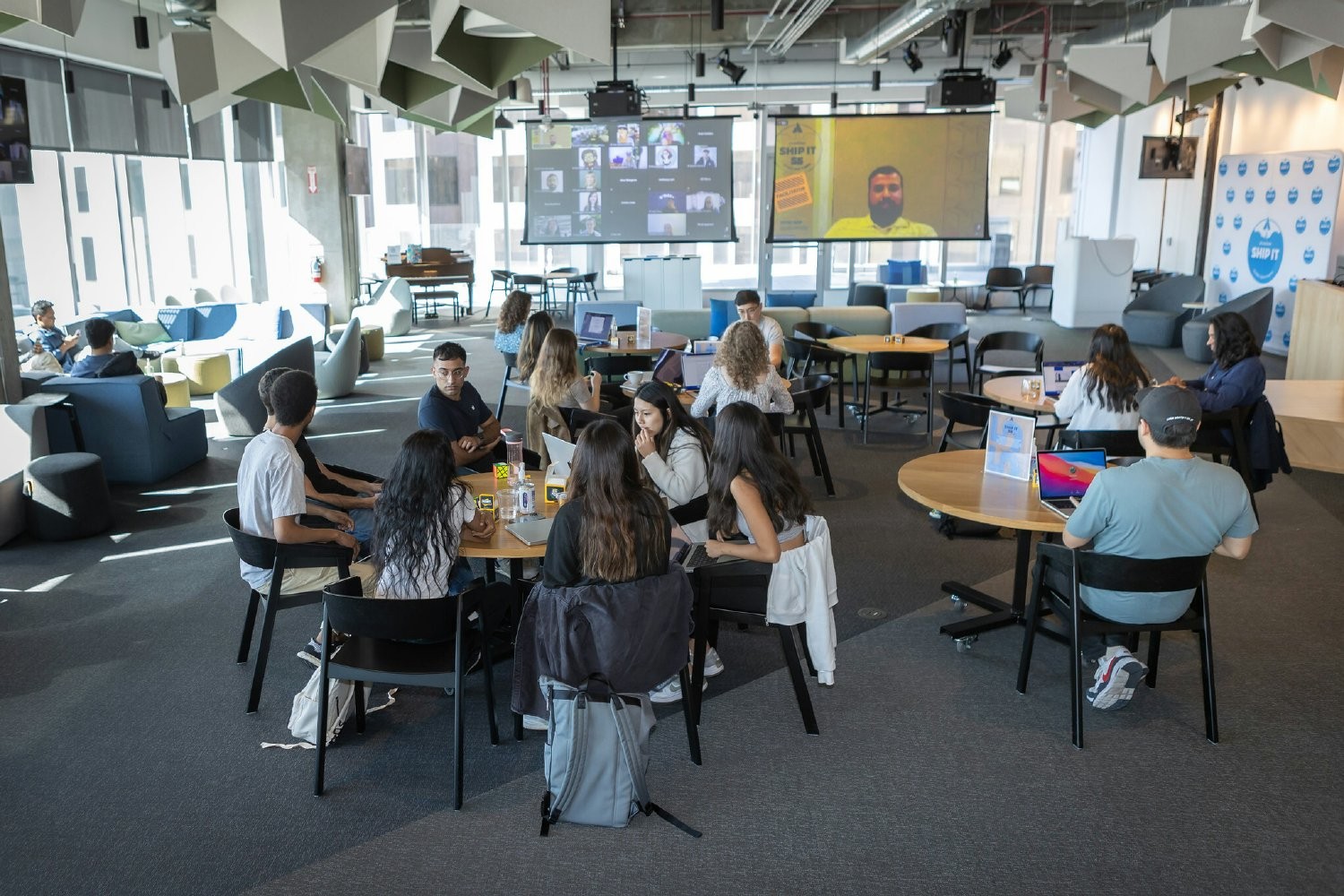Remote & Hybrid Culture, Research
Check out these insights for setting remote work policy in industries from tech and finance to health care.
Does your company need to offer remote work options to be competitive when recruiting top talent?
Great Place To Work® identified unique challenges and opportunities created by remote work depending on your industry. While industries like health care, retail, or manufacturing all have operational challenges in offering remote work, the data shows that flexibility can have real benefits for employees — and drive higher levels of engagement and retention.
But what does flexible work look like in practice, and how does the data match up with what companies at the Best Workplaces™ are doing?
Here are some examples of how companies across industries are embracing flexibility and creating a competitive advantage for their business.
Technology
Technology workers can easily adapt to remote work environments, and in the early days of the pandemic, many technology companies were quick to announce they would offer remote work indefinitely.
However, the data shows that remote work does create challenges for workplace culture. Compared with tech workers who work remotely, employees that work onsite at a tech company were more likely to say management has a clear vision for the company (21%) and more likely to say management keeps its promises (20%).
In-person workers were also 20% more likely to report having special and unique benefits, which proves that offering remote work, on its own, isn’t enough to create a highly competitive workplace culture.
Here some ways that technology companies can stand out from the pack as they navigate their future around remote work:
1. Ensure that remote employees can participate in company activities and have unique experiences tailored to them
At Cisco, enabling remote work means building new technology to optimize collaboration between in-person and offsite team members.
Some of the innovative new tools include a camera that focuses on a speaker as they move, AI transcription and translation tools, new whiteboard co-creation tools, headsets that filter out background noise, and more.
Beyond investing in tools to help employees connect, great workplaces also consider how to make sure remote employees feel connected to the wider organization. If you have a company celebration, how can you help every employee participate?
Virtual events should receive the same care and attention to detail that is paid to in-person activations.
2. Make an extra effort to get feedback from remote employees
If on-site employees are more likely to say that management keeps its promises, that might indicate leaders are communicating more effectively with these employees.
Listening can make a huge difference in how leaders build trust with employees, and tech companies with remote or hybrid employees should consider how their listening efforts might overlook workers who are not physically present.
When Adobe shifted to a hybrid work model in 2020, it turned its Lab82 project into a global human-centered experiment to uncover new ways of working. The project tested new ways for in-person and remote employees to collaborate, new processes for onboarding employees, and programs to help employees connect with each other. After each experiment, the team collected feedback from participants and made recommendations to the organization for new policies.
3. Retrain managers to build connection with remote employees.
Managing employees remotely requires a slightly different skillset, and great workplaces are offering their people leaders training to adapt to new models and workflows.
At Cisco, managers were trained on a new set of Collaboration Commitments, expectations and companywide values around how people work together and show up to work every day. New policies were introduced that empowered teams to set their own hybrid work policies that balanced the needs of team members and the realities of business operations.
Managers also received a “Hybrid Quick Start Guide” to help leaders navigate setting new team norms and rituals. Teams could also participate in workshops where they could work together to set new rules for how their team would work together.
Health care
While there are challenges to offering remote work in health care, the data shows that there are clear advantages for employees who have remote work options.
And HR leaders in health care see increasing flexibility as an inescapable reality for the future of the industry.
“We have to start thinking differently,” Gina Ebersole, assistant vice president of talent strategy at Main Line Health tells Great Place To Work. “What is the other choice? We can continue in our same model experiencing staffing shortages and keep fighting it, expecting it to go back to the way it was. But it’s not going to go back to the way it was.”
The data shows that employees who work remotely in health care are more likely to say they have special and unique benefits (24%) and more likely to say their manager understands what is important to them (22%).
Here’s how great workplaces in health care are solving challenges to overcome the challenges posed by in-person work restrictions and remain competitive in the search for top talent:
1. Find unique ways to recognize the service of on-site health care employees
Remote employees were 14% more likely than in-person employees to say that every employee is valued as a full member of the team. For health care companies, that means looking at efforts to recognize and reward the service of on-site employees.
At Atlantic Health System, leaders wanted an improved way to reward and recognize team members and in June of 2022, it launched a revamped platform for recognition called “CELEBRATE.”
The platform allows employees to recognize each other, and leaders can recognize team members with points that can be redeemed as gifts. However, what really sets apart Atlantic Health’s recognition platform is the way the tool was enabled across the workforce.
Monthly leadership training sessions were held to educate leaders about the tool, and a special celebration dinner recognized leaders who were highly engaged in recognizing their teams on the platform. To reach frontline employees, the company created printed materials including tent cards, flyers, and posters — and used QR codes so employees could easily access nomination forms on their phones.
For health care companies, recognition must consider the realities of the work environment, where employees don’t sit behind a computer screen. Just having a recognition program isn’t enough. How you enable the program makes the difference between a truly great workplace culture and the alternative.
2. Listen carefully to uncover the challenges that make remote work attractive to health care employees — and design benefits to address those issues
What do your employees value about the ability to work remotely? There might be other ways to solve for their specific needs without offering remote or hybrid work.
Employees might want flexibility to attend family events, balance childcare and work responsibilities, or better manage their work-life balance. How can your organization offer programs that address their concerns?
It starts with listening, and great workplaces in health care take surveys and listening sessions very seriously.
At Wellstar Health System, every team is asked to develop an action plan based on its annual Great Place To Work survey. A cross-function group of 15 frontline managers and one physician also offer feedback as part of the “Wellstar Trust Collaborative.”
Texas Health Resources touts its “Open Door, Empty Chair” practice as crucial for ensuring leaders spend time getting direct feedback from employees. Any time an employee wants to talk to their manager, or any leader, they can reach out for a meeting to share concerns.
Leaders also participated in a listening tour, doing rounds with staff to hear face-to-face from employees about their challenges, successes, and ideas for improvement.
3. Challenge norms and traditions to offer the maximum amount of flexibility to workers without compromising patient care and safety
Many roles in health care can’t be performed remotely, but there are other ways to offer flexibility.
At Atlantic Health System, flexible work arrangements allow team members to better accommodate their scheduling needs. Many team members can self-schedule, choosing shifts that work best for them. Team members can choose to work with favorite colleagues or they can prioritize times of the day, which allows them to manage childcare or at-home responsibilities.
At Texas Health Resources, every department leader of a remote team was asked to submit a plan for returning to the office in 2022. Leaders surveyed their teams to get input, creating a hybrid work policy built on employee feedback.
The best workplaces are listening to the specific needs of their employees, and questioning industry norms that no longer benefit workers or patients.
Finance
Companies in the finance and insurance sector have been at the center of the remote work debate for years. Banks like Citigroup, Barclays, and HSBC made news in 2024 when they changed remote work policies to require employees to report to the office full time rather than inspect home offices to meet federal regulations.
Others in the sector have been pushing employees to come back to the office since 2023 or earlier.
But what does the data say about remote work in the finance industry? Interestingly, Great Place To Work found that employees who work in-person are 24% more likely to say management keeps them informed, and 22% more likely to feel like they make a difference at work, compared with remote employees.
They are also 21% more likely to say their manager cares about them — revealing that managers of remote workers in finance should take a closer look at their efforts to stay connected to employees.
Here’s how great workplaces are overcoming these challenges:
1. Increase efforts to communicate with remote employees
Offering remote or hybrid work isn’t what determines your workplace culture. Instead, how your values permeate your remote work policies and norms are what set great workplaces apart.
The data shows that remote employees have a weaker connection with leaders than in-person employees at a typical workplace in finance. Great workplaces outperform the typical workplace by embracing a wide range of communications tools.
At American Express, CEO Stephen J. Squeri hosts quarterly town halls to share updates and connect with employees. Business unit leaders also hold town halls for their organizations, host Ask Me Anything sessions on Slack, share video messages, and make themselves available for office hours.
2. Support managers in building relationships with remote workers
Great workplaces are invested in providing every employee, whether remote or in-person, with a great manager who is invested in their success. That often requires a significant investment in leadership training.
At Synchrony, the top 300 senior leaders at the company were enrolled in a training program to ensure that employees had a people leader that embodied the company’s values. Leaders were brought together for an event that lasted two and half days that included role playing, networking, training on inclusion and belonging, and wellness programming in partnership with Thrive Global.
At Nationwide, leaders can participate in a program called “Future Ready Leader” — a fully-remote offering where participants select a four-week learning program. Each session includes individual learning, engagement with peers and networking, and practice where leaders can apply their new knowledge to their current work. Nationwide also hosts monthly forums to help leaders share knowledge and grow skills to manage employees in a virtual environment.
3. Help remote workers find deeper meaning with their roles
Having meaningful work — or a sense of purpose — is a crucial aspect of the employee experience that drives higher levels of retention for employees.
At Nationwide, more than half of associates permanently work from home and over 35% have selected a hybrid work option. To ensure that employees still build a strong connection to the company and find meaning in their work, the insurance provider offers a variety of ways for associates to connect.
“MENTORwide” is an on-going mentorship program that connects employees for learning and networking. Any associate can be a mentor, mentee, or both. The program consists of three one-on-one conversations to be held within a 90-day span.
Employees can also connect through employee resource groups — at Nationwide, called “Associate Resource Groups.” These groups can help employees tap into the deeper values and goals of the business, such as with the Green Team, which is helping to create a more sustainable future for the company and the communities where Nationwide operates.
Get more industry insights
Check out the full “Return to Office Mandates and the Future of Work” report from Great Place To Work to learn how your industry is affected by remote work, with benchmarks for the employee experience across the U.S.











